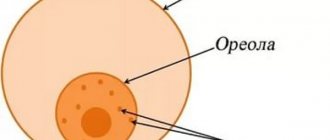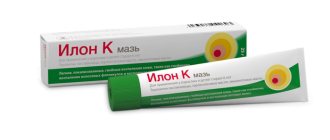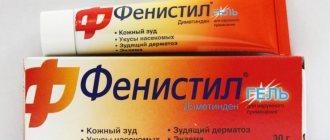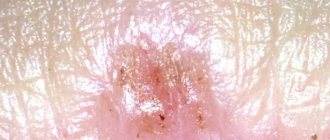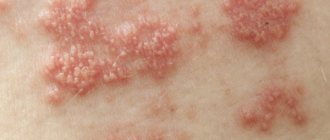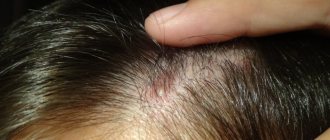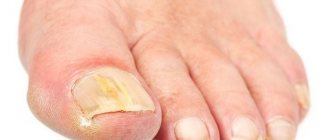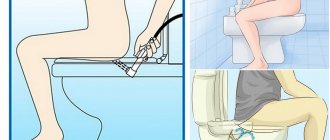A carbuncle is an acute purulent inflammation in the epidermis and subcutaneous tissue, formed around several hair follicles and sebaceous glands. In fact, a carbuncle is a collection of fused boils (purulent inflammation of hair follicles), complicated by the formation of a large necrotic area in the soft tissues.
What kind of disease is this?
This formation received its name from the Greek word “ Carbo ”, which means black coal.
The healers of those times, having seen what a pimple looked like, immediately “christened” it that way because of the accumulation of black purulent-necrotic exudate at the site of its formation.
In practice, it is difficult for people without medical education to distinguish between a boil and a carbuncle , the difference being the larger area of infiltration and the depth of the lesion. In simple terms, a carbuncle is a cluster of boils, which over time form a single affected area with signs of suppuration. But individual furunculous formations can open spontaneously, but the focus of suppuration in the carbuncle cannot break out without surgical intervention.
Carbuncle occurs most often in teenage boys and young men (2 times more often than in girls, young women and women), apparently this is due to excessive load on their sweat and sebaceous glands and the active production of sex hormones in the body.
Another feature of this pathology is that more than 50% of all diagnosed cases occur in the hot summer period.
Carbuncles usually appear on the face and neck, on the back, in the forearms, on the arms or legs, and on the buttocks. As a rule, these formations are single, but sometimes several appear at once.
How to treat a carbuncle is determined by the surgeon, since this is a serious infection that requires the attention of medical workers and self-medication can lead to the development of serious complications (abscesses, cellulitis, sepsis).
Complications of carbuncle
The occurrence of a carbuncle is fraught with various complications. This is due to the fact that the causative agent of the disease penetrates the body tissues through the vessels and enters the blood. Complications in the presence of a carbuncle can be observed in people who practically do not receive adequate treatment, and their health is already weakened during the course of the disease.
In soft tissues, under the influence of infection, phlegmon, or abscess, forms. If bones become infected, there is a risk of osteomyelitis. If the infection spreads to the blood vessels, a person may develop thrombophlebitis; patients often experience bleeding. In complex forms of the disease, erysipelas of the skin may develop in parallel.
Carbuncles that appear on the face can lead to serious complications. Such formations, if untreated, can provoke the disease of purulent meningitis if the infection affects the brain. The pathogen enters the blood, sepsis develops in the body, this process often leads to death of the patient.
ICD-10 code
Carbuncle belongs to the group of infectious skin diseases with the code - L00-L08 .
It includes:
- carbuncle on the skin ( L02 );
- carbuncle in the facial area ( L02.0 );
- carbuncle of the neck ( L02.1 ) and body ( L02.0 );
- carbuncle of the buttocks ( L02.3 );
- carbuncle of arms and legs (L02.4);
- carbuncle of other ( L02.8 ) or unrefined localization ( L02.9 ).
Physiotherapeutic procedures
Physiotherapy is one of the quite effective additional methods of carbuncle treatment:
- X-ray therapy is used at the initial stage of inflammation, the number of procedures is determined by the doctor;
- UHF therapy (exposure to ultra-high frequency electromagnetic fields);
- UFO therapy (irradiation with ultraviolet waves);
- laser and magnetic therapy.
These procedures help to activate blood flow in the area of inflammation, reduce the amount of necrotic tissue and accelerate their rejection, and prevent the spread of infection to healthy skin.
Causes
The disease usually develops with a combination of external and internal factors and a decrease in the body's defenses.
The reasons for the appearance of a carbuncle include:
- Active reproduction of pathogenic organisms on human skin.
- Violation of the integrity of the epidermis (wounds, scratches, splinters, insect bites, calluses, scratches, bruises, abrasions).
- Excessive sweating (hyperhidrosis).
- Disruption of the sebaceous glands.
- Poor facial and body hygiene.
- Endocrine pathologies (disorders of the thyroid or parathyroid glands, adrenal glands) and metabolic diseases (diabetes mellitus, obesity).
- Immunodeficiencies and hypovitaminosis.
- Frequent infectious diseases (ARVI, influenza, parainfluenza, tonsillitis, pharyngitis, tonsillitis).
- Serious chronic pathologies (arthritis, myocarditis, hepatitis).
- Poor nutrition and inactive lifestyle.
- Stress and psycho-emotional stress.
Prevention
To prevent the formation of carbuncles, the following measures must be observed:
- keep your body, hands and underwear clean;
- do not use other people’s personal hygiene items;
- wash regularly with antibacterial soap;
- take a shower and wash clothes after being in dusty places;
- Do not squeeze pus out of pimples yourself;
- avoid hypothermia and drafts;
- increase the body's immunity in all ways;
- treat colds and general diseases in a timely manner;
- lead a healthy lifestyle;
- treat cuts, abrasions, skin irritations with an antiseptic, try to avoid damage;
- wear loose clothing made from natural, easily washable fabrics.
Video: what you need to know about carbuncle
Kinds
- A traditional carbuncle forms on the face, body, limbs and torso and develops according to classical canons in several stages.
- Kidney carbuncle . Occurs as a complication after suffering pyelonephritis. Its manifestation is similar to inflammatory kidney diseases and is sometimes difficult to distinguish from them. Symptoms of the disease include fever, intoxication and pain in the lumbar region. Differential diagnosis using X-ray and ultrasound methods helps to identify pathology.
- Emphysematous carbuncle . It does not develop in humans; it affects cattle. When infected with a pathogenic microorganism, many swellings are found on the body of animals, they quickly weaken and die from cardiac and respiratory failure.
- Anthrax carbuncle . It is formed when a person is infected with the anthrax bacillus, has a severe course and is extremely contagious to others.
Drug therapy
Recommended:
- antibiotics in large doses - Penicillin, Streptomycin, Biomycin. Course – 7–10 days;
- Injections of Penicillin into the affected area have a good effect. In severe cases, the daily dose can reach up to 1,000,000 units;
- drugs that regulate cardiac activity;
- Norsulfazole - four times a day, 1 g, Streptocid - after 4-6 hours, 0.5 g. The drugs relieve inflammation;
- painkillers: Ketanov, Solpadeine;
- the surface of a ripening and ruptured abscess is treated with methyluracil ointment, and compresses are made with Vishnevsky ointment. These compounds accelerate the maturation of the abscess and increase the release of purulent masses;
- the infiltrate is wiped with 70% ethyl alcohol. Without regular disinfection, the risk of secondary infection increases.
Important! Physiotherapeutic procedures - UVF therapy, UV irradiation - accelerate wound healing.
Symptoms
Doctors define the disease as a dermatological and surgical disease caused by staphylococci and streptococci and distinguish several stages in its development:
- Infiltration (its duration is 1-2 weeks). It begins from the moment microorganisms enter the surface layers of the epidermis and the base of the hair follicle, then an inflammatory process begins in the area of infection with reactions of redness and swelling of the skin, which rapidly spreads and covers already healthy areas of the skin.
Photo of the first stage
At the same time, the blood in the capillaries becomes very viscous and therefore blood clots appear, so the site of inflammation quickly darkens or turns black.
- Suppuration (lasts 10-20 days). It begins with the formation of purulent-necrotic masses in the center of the carbuncle, and in some places holes appear from which purulent exudate flows.
Stage of suppuration
At this stage, the lesion resembles a large ulcer that penetrates the soft tissues right down to the bones; they quickly become saturated with purulent fluid and die, which is why large areas of necrosis are visible around the base of the carbuncle.
One of the external signs of how a carbuncle differs from a boil is that the stage of spontaneous release of pus to the surface does not exist in the first, but in the second it does, therefore, in case of a carbuncle, in order to completely cleanse its cavity, it is recommended to surgically open it and aseptically clean the resulting cavity . Conservative therapy is usually used at the first stage of development of this pathological formation.
General damage to the body during carbuncle includes: fever, intoxication, general weakening of the body.
Stages of disease development
The disease goes through several stages of development:
- Initially, several compacted nodules appear, which over time merge into a single whole with a bluish center. Gradually increasing, the infiltrate reaches the size of a child's hand, spherical in shape. How many days does it last? The duration of the stage is about 12 days.
- The pustules formed in the lesion are opened, and purulent exudate mixed with blood and dead pieces of tissue begins to be released through the wounds. This place begins to increase in size, and after opening, a deep ulcer forms. The duration of the period is from two to three calendar weeks.
- The healing ulcer is filled with granulation tissue, with the gradual formation of a deep scar.
In the initial days, when the first signs appear (if measures are taken quickly), treatment of the carbuncle may be limited to local therapy.
Treatment
Drug therapy is used at the infiltration stage and can help avoid further development of the disease, suppuration and tissue necrosis.
Your doctor will recommend how to treat carbuncle at home quickly and effectively.
Typically, surgeons or dermatologists prescribe a course of antibiotics to which staphylococci are sensitive (Ampiox, Ceftriaxone, Gentamicin, Doxycycline, etc.), and ointments or emulsions (synthomycin, streptomycin, levomikol) are prescribed locally for outpatient use. Additionally, the carbuncle is pricked with antibacterial agents and its surface is treated with antiseptics (usually a 70% alcohol solution), but this is already in a clinic setting.
If in a timely manner , it is possible to initiate a reverse mechanism for the regression of the carbuncle and achieve resorption of the infiltrate and complete restoration of the skin and its functions.
In the stage of suppuration, the main guarantee of recovery is surgical opening of the abscess and removal of the pathological contents from it.
Carbuncle: photo
After the operation, the resulting cavity is tamponed using proteolytic enzymes and a hypertonic NaCl solution or, if necessary, drained, and a sterile dressing is applied on top, which is changed daily.
With a large area and depth of damage, the wound surface heals with the formation of scar tissue.
For their regeneration, after opening the carbuncle and fusion of the wound edges, physiotherapeutic methods are used (UVR, UHF, ultraviolet or intravenous laser irradiation of blood), and long-term intake of vitamins and mineral complexes is prescribed.
Indications for hospitalization are severe symptoms of intoxication (dehydration, high temperature, severe weakness), localization of the carbuncle on the face or head, the presence of underlying diseases (systemic, autoimmune, diabetes mellitus, anemia, malignant neoplasms, immunodeficiencies).
Therapeutic regimens
Significant differences between the two types of ulcers lie in the approaches to their treatment. Boil therapy is mainly carried out using local remedies in the form of ointments, creams and solutions. If the ulcers are multiple, then measures are aimed at strengthening the immune system. If the boil does not open on its own for a long time, surgical excision under local anesthesia is possible.
Treatment of carbuncle takes place exclusively under medical supervision on an outpatient basis or in a hospital, depending on the size, stage of inflammation and the general well-being of the patient. Therapy uses broad-spectrum antibiotics for oral administration, injecting the source of inflammation with antibacterial drugs, the use of painkillers, but also, of course, surgical treatment.
Preventive recommendations
Carbuncles are an unpleasant, dangerous phenomenon. It's easier to warn him than to fight an abscess. Doctors' recommendations will help avoid severe damage to the skin and subcutaneous tissue.
What to do:
- strengthen the immune system, be less nervous, avoid overwork, rest enough time;
- take care of your body hygiene. Take a shower daily, cleanse your face thoroughly, don’t forget about your neck, especially the back of your neck;
- wash with soap the places where there is constant friction between the epidermis and hard parts of clothing, for example, on the neck on the collar;
- don't squeeze pimples. If you removed the abscess yourself, be sure to wipe the area with any disinfectant solution;
- In hot, humid weather, shower more often, even without soap or gel. Pathogenic microbes are more likely to multiply on dirty, sweaty skin;
- When working in harmful conditions, thoroughly clean your skin after your shift, try not to touch your face or neck with dirty hands. If possible, wipe these areas with a clean, damp towel or rag as you work;
- in case of increased sweating, take baths with oak bark, string, sage, chamomile, use talcum powder, powder;
- eat properly and fully. In autumn, winter, spring, take multivitamins, buy frozen vegetables, fruits, eat citrus fruits to get the required amount of vitamins;
- control chronic pathologies, prevent relapses;
- Do not scratch insect bites: the infection will easily penetrate the wound.
Carbuncle causes a lot of trouble for a person faced with this misfortune. Timely consultation with a doctor and complex therapy will relieve the scourge. Be healthy!
From the following video you can learn even more details about the carbuncle:
